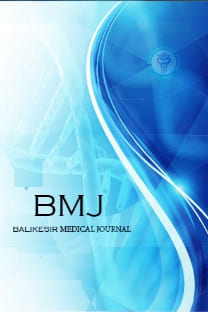Tip 2 Diyabetli Hastalarda Oral Anti Diyabetik İlaçların HBA1c, Obezite ve Komplikasyonlar ile İlişkisi
Amaç: Tip
2 diyabetes mellitus hastalarının kullandıkları oral anti diyabetik tedavilerin
glisemik kontrol, vücut kitle indeksi ve komplikasyonlarla ilişkisinin
değerlendirilmesi.Yöntem: Okmeydanı
Eğitim ve Araştırma Hastanesi Aile Hekimliği Poliklinikleri’ne başvuran 18 yaş
ve üzeri tip 2 diyabet tanılı hastalardan son 6 aydır tek başına ya da
kombinasyon şeklinde oral anti diyabetik kullanan, gönüllü 270 hasta çalışmaya
alındı. Bozulmuş açlık glukozu ve/veya bozulmuş glukoz toleransı olan hastalar,
insülin kullanan hastalar çalışmaya dahil edilmedi. Karşılaştırmalarda t testi
ve ki kare analizleri kullanıldı. P<0,05 anlamlı kabul edildi.Bulgular: Katılımcıların %46,7 si erkek, %53,3 ü kadın olup grubun yaş ortalaması
53.9 (±0.7)’dur. 270 hastadan 82’sinin (%30,4) kan şekerinin regüle olduğu,
188’inin (%69,6) kan şekerinin regüle olmadığı saptandı. Kan şekeri regüle olan
grupta her üç kişiden birinde mikrovasküler komplikasyon saptanırken; regüle
olmayan grupta bu oran daha yüksek tespit edildi. Kan şekeri regüle
olmayanlarda daha fazla makrovasküler komplikasyon görüldüğü gözlendi. Kan
şekeri regüle olanların çoğunlukla tek ve/veya ikili ilaç kullandığı, regüle
olmayanların ikiden fazla ilaç kullandığı saptandı.
Sonuç:
Çok sayıda oral anti diyabetik tedavi seçenekleri bulunmasına karşın önemli
sayıda diyabetik hasta kötü glisemik kontrol, obezite ve bunun bir sonucu
olarak komplikasyonlar ile yaşama riski altındadır.
Anahtar Kelimeler:
oral anti diyabetik, tip 2 diabetes mellitus, vücut kitle indeksi, komplikasyon
The Relationship between Oral Anti Diabetic Drugs with HBA1c, Obesity and Complications in Type 2 Diabetic Patients
Objective:
Evoluation of oral anti diabetic medication used by
type 2 diabetes mellitus patients in relation to glycemic control, body mass
index and complications.Methods:
270 volunteer patients, over 18 years of age, who
applied to Family Medicine Clinics of Okmeydanı Training and Research Hospital,
diagnosed with type 2 diabetes who were taking oral anti diabetic drugs for the
last 6 months alone or in combination were taken to study. Patients with
impaired fasting glucose and/or impaired glucose tolerance, patients using
insulin were not included in the study. In the comparison, t-test and
chi-square analyzes were used. P <0.05 was considered significant.Results:
46.7% of the participants were male, 53.3% were female
and the average age of the group was 53.9 (± 0.7). 82 of 270 patients (30.4%)
were found to have regular blood sugar and 188 (69.6%) were not found to have
regular. Microvascular complications were detected in one of three individuals
in the regular blood glucose group; this rate was higher in the irregular
group. More macrovascular complications were observed in the irregular blood
glucose group. It was revealed that those who have regular blood sugar mainly
used single and/or dual drugs, those who have irregular blood sugar use more
than double drugs.
Conclusion: Despite
the large number of oral anti diabetic treatment options, a significant number
of patients with tip 2 diabetes mellitus are under the risk of living with poor
glycemic control, obesity, and complications
___
- 1. SATMAN, İlhan, and Turdep-II Çalışma Grubu. "Türkiye Diyabet Prevalans Çalışmaları: TURDEP-I ve TURDEP-II." (2011).
- 2. Satman, I. ,and TURDEP-II Çalışma Grubu. "TURDEP-II Sonuçları." Türk Endokronoloji ve Metabolizma Derneği (2011).
- 3. Intensive blood-glucose control with sulphonylure as or insulin compared with conventional treatment and risk of complications in patients with type 2 diabetes (UKPDS 33). UK Prospective Diabetes Study (UKPDS) Group. Lancet 1998;352:837-53.
- 4. Jensen-Urstad KJ, Reichard PG, Rosfors JS, Lindblad LE, Jensen-Urstad MT. Earlyatherosclerosis is retarded by improved long-term blood glucose control in patients with IDDM. Diabetes 1996;45:1253-8.
- 5. Ohkubo Y, Kishikawa H, Araki E, et al. Intensive insulin therapy prevents the progression of diabetic microvascular complications in Japanese patients with non-insulin-dependent diabetes mellitus: A randomized prospective 6- year study. DiabetesResClinPract 1995;28:103-17.
- 6. Reschard P, Nilsson BY, Rosenqvist U. Theeffect of long-term intensified insulin treatment on the development of microvascular complications of diabetes mellitus. N Engl J Med 1993;329:304-9.
- 7. American Diabetes Association. Executive summary: Standards of medical care in diabetes-2009. Diabetes Care 2009;32(Suppl 1):6-12.
- 8. Chan JC, Gagliardino JJ, Baik SH, et al. Multifaceted determinant forachievingglycemiccontrol. The International Diabetes Management PracticeStudy (IDMPS). Diabetes Care 2009;32:227-33.
- 9. Rodbard HW, Blonde L, Braithwaite SS; et al. AACE Diabetes Mellitus Clinical Practice Guidelines Task Force. American Association of Clinical Endocrinologists medical guidelines for clinical practice for the management of diabetes mellitus. EndocrPract 2007;13:3-68.
- 10. The Diabetes Control and Complications Trial Research Group. The effect of intensive treatment of diabetes on the development and progression of long-term complications in insulin-dependent diabetes mellitus. N Engl J Med 1993; 329:977-986.
- 11. Handelsman Y, Bloomgarden ZT, Grunberger G et al. American association of clinical endocrinologists and american college of endocrinology - clinical practice guidelines for developing a diabetes mellitus comprehensive care plan - 2015. Endocr Pract 2015; 21 Suppl 1:1-87.
- 12. Joseph L Evans, Ph.D., Börk Balkan, Ph.D., Eunice Chuang, MD, and Robert J Rushakoff, M.D. Oral and Injectable (Non-insulin) Pharmacological Agents for Type 2 Diabetes
- 13. Sağlık Bakanlığı Türkiye Obezite ile Mücadele ve Kontrol Programı (2010-2014)
- 14. A Onat, İ Keleş, A Çetinkaya, Ö Başar… - Türk Kardiyoloji Derneği, 2001 - tkd.org.tr-TEKHARF Çalışması.
- 15. A Kaya - Tip 2 DM'de oral antidiyabetik tedavi. 6 İç Hastalıkları kongresi - tihud.org.tr
- Yayın Aralığı: Yıllık
- Başlangıç: 2017
- Yayıncı: Balıkesir Üniversitesi
Sayıdaki Diğer Makaleler
Az Bilinen Bir Konu ‘Rapunzel Sendromu’: Bir Olgu Sunumu
Beyza MAHMUDOĞLU, Nursel DİLEK, Çiçek HOCAOĞLU
Flora Ozkalaycı, Oyku Gulmez, Bulent Sarıtas
Türkiye’de bir şehir merkezinde yaşayan süt çocuklarında ev içi elektromanyetik alan maruziyeti
Basak YİLDİZ ATİKAN, Mehmet Dinçer BİLGİN, Sadık AKŞİT
Sevilay ÖZMEN, Hilal BALTA, İlknur ÇALIK, Şenay ERDOĞAN DURMUŞ, Rabia DEMİRTAŞ, Bülent ALBAYRAK, Ali KURT, Sare ŞİPAL
Ege AĞIRMAN, Bahar Marangoz, Mehmet Ziya Gençer, Seçil Arıca, Kübra Zegerek
Overde Matür Kistik Teratom İçerisinden Gelişen Karsinoid Tümör
